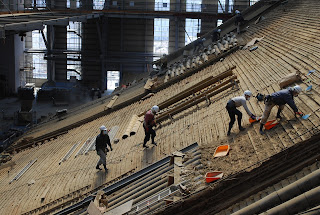12 March 2012
Nami-sensei, our Japanese tutor, teaches part time at Kino Kuni Children's Village, an alternative school for grades 1-12 located in a remote, mountainous setting. (Above photos are not mine.) The school's founder was deeply influenced by the writing of John Dewey and especially A.S.Neill (founder of Summerhill in England). The school, as I understand it, is an open and democratic community (eg teachers are not addressed as so-and-so-sensei, no uniforms etc) which stresses the dignity of each child. The children learn from projects, which include architecture, construction, farming, theatre, crafts, and, of course, cooking. Classes all include children of various ages, and are often facilitated by students themselves instead of teachers. There are also formal academics in the schedule, mostly interdisciplinary. 80% of the students board, even 6 year olds (!), going home each weekend for 3 nights. The physical setting is definetely rough, but computers seem plentiful. In one elementary school class I observed, children were studying India, and seemed to be giving reports on a variety of topics, while the teacher used the opportunity to practice writing, teach about time changes around the world, do geography, talk about the size of Bengal tigers etc etc. The class lasted an hour and a half. Older kids look out for the younger ones.
My assigned role in the morning was to join the lower/middle school cooking class, where the children have been learning about the use of beans in various cultures (they had made tofu, shoyu, miso from soy beans, cooked "Mexican chili" and "Brazilian black beans" and now it was time for BOSTON BAKED BEANS!). So armed with molasses and Worcestershire sauce brought over by Tim and Marg, and with the rest of the ingredients supplied by the school and the beans boiled earlier in the morning, we went to work. The onions and bacon were perfectly diced and cubed by small children wielding sharp knives. With no measuring, we added all the necessary ketsup, mustard, molasses, etc, etc, put the pot on the stove, boiled the mess for a while, and ended up with something remarkably like baked beans!!!! This was a big relief to me, since every recipe calls for 5 hours of baking. Then we had questions about American food and the role of beans...I described Native Americans helping the Pilgrims keep from starving in 1621, then about Thanksgiving (no one eats turkey in Japan), taught them to say Massachusetts (!), was asked it that was near the Kennedy Space Center, and then we all had lunch and ate beans.
I had a great time, wished I could learn more about the school. It is so different from the usual school here, where children all wear blazers, knee socks neatly pulled up, pleated skirts, shorts for little boys, sometimes sailor shirts, ties etc. In some schools, older boys wear military type uniforms. Summerhill it is not for most Japanese kids.
Arrived back in time to have a great last dinner with Tim and Marg at Iroha, a lovely Suki yaki restaurant on Pontocho. We all enjoyed the meal, and have become accustomed to dipping the cooked meat and vegetables into raw egg.
With love

















































